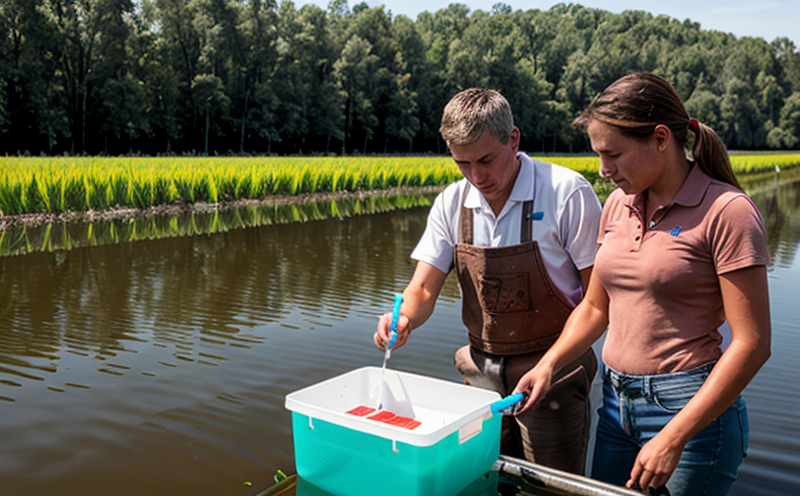Mercury Content Testing in Agricultural Water
The testing of mercury content in agricultural water is a critical component in ensuring food safety and environmental sustainability. Mercury contamination poses significant risks to both human health and the ecosystem, making it imperative for farmers, quality managers, compliance officers, and R&D engineers to implement rigorous testing protocols.
Mercury can enter agricultural water through various means such as atmospheric deposition from industrial emissions, improper disposal of mercury-containing products, or leaching from contaminated soil. Once introduced into the water system, mercury can accumulate in crops and livestock, leading to potential health risks when consumed by humans. Therefore, accurate and reliable testing methods are essential for monitoring and controlling mercury levels.
Standard testing methodologies include atomic absorption spectroscopy (AAS) and cold vapor atomic fluorescence spectrometry (CVAFS). These techniques provide precise measurements of total mercury content, ensuring compliance with international standards such as ISO 17025. The testing process involves collecting water samples from various sources within the agricultural landscape, including irrigation systems, ponds, and runoff channels.
Proper sample preparation is crucial for accurate results. This includes filtering the water to remove particulate matter, adjusting pH levels if necessary, and ensuring that the sample remains stable until analysis. Once prepared, the samples are analyzed using advanced instrumentation capable of detecting trace amounts of mercury down to parts per billion (ppb).
The importance of this test cannot be overstated. By identifying and quantifying mercury contamination early in the agricultural process, stakeholders can take proactive measures to mitigate risks. This may involve adjusting irrigation practices, implementing better waste management protocols, or adopting alternative fertilizers.
Compliance with regulatory requirements is another key benefit of mercury content testing. Many regions have established limits for permissible levels of mercury in water used for agriculture, and failure to meet these standards can result in fines or sanctions. Regular testing ensures continuous adherence to legal guidelines, protecting both the environment and public health.
In addition to regulatory compliance, implementing this test allows organizations to maintain their reputation as responsible stewards of natural resources. Consumers are increasingly aware of environmental issues and expect companies to demonstrate commitment to sustainable practices. Demonstrating robust quality control measures through mercury testing reinforces this image and fosters customer trust.
Why Choose This Test
Mitigates health risks associated with mercury exposure.
Avoids penalties for non-compliance with environmental regulations.
Ensures product quality and safety for consumers.
Supports sustainable agricultural practices by identifying contamination sources.
Enhances reputation among stakeholders through transparent testing protocols.
Environmental and Sustainability Contributions
Testing for mercury content in agricultural water plays a vital role in promoting environmental sustainability. By detecting and addressing contamination issues early, organizations contribute to cleaner ecosystems and healthier communities.
The testing process itself is designed with minimal impact on the environment in mind. Sample collection methods are carefully selected to minimize disturbance to local habitats, while laboratory procedures adhere to best practices for waste management and resource conservation.
Furthermore, the insights gained from this testing enable more informed decision-making regarding agricultural practices. This can lead to reduced use of harmful chemicals, improved water usage efficiency, and enhanced overall environmental stewardship.
Use Cases and Application Examples
| Case Study | Description | Results |
|---|---|---|
Agrifood Exporter |
An international agrifood exporter sought to ensure compliance with EU regulations regarding mercury levels in agricultural water. Samples were collected from multiple sources across different regions. |
All samples met the required standards, enabling the company to continue exporting products without interruption. |
Local Farmer Co-op |
A cooperative of local farmers conducted regular testing to monitor water quality in their irrigation systems. This helped them identify and rectify minor issues before they became major problems. |
The initiative led to improved crop yields and reduced risk of contamination, enhancing both productivity and reputation. |
Water Management Authority |
A regional water management authority implemented a comprehensive testing program across all agricultural areas within its jurisdiction. This helped them identify high-risk zones requiring targeted interventions. |
The results informed strategic investments in infrastructure improvements and public awareness campaigns, leading to overall better resource management. |





